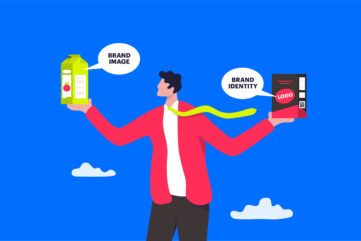Branding tips: 12 essential tips on branding to skyrocket your brand

The right branding tips and guidance can ensure you make the most out of your company’s presence, voice, and image. After all, there’s much more to building a cohesive, impactful brand than producing an eye-catching logo.
In a world of increasing competition for customer attention, your brand often determines if your business thrives or falters.
In today’s technologically advanced landscape, anyone can build a website and sell products and services. However, not every new company will have what it takes to connect with customers emotionally and pave the way for long-term sales.
Branding defines how your customers perceive you, whether they feel connected to your company and invested in the solutions you have to offer.
Perhaps most importantly, your brand forms the foundations for trust – the thing 81% of customers say they need to feel about buying from a company.
So, how do you ensure your brand has the right impact? Today, we will cover some of the top branding tips we’ve collected through years of experience building, supporting, and optimizing brands across multiple industries and verticals.
Let’s get started.
Why companies need branding tips
The power of branding
Branding isn’t a new concept. Since companies started selling their wares and services to consumers and other businesses, they’ve been experimenting with brand identity. However, the concept of branding is still widely misunderstood.
Countless business leaders still believe their “brand” is just a combination of the right color palette, logo, and website design. However, there’s a lot more to what makes your business stand out than your visual identity.
Branding is what convinces your audience you share their values and visions. It’s what transforms you from just another faceless company to the ultimate solution for your target audience’s pain points and problems.
Establishing a clear branding strategy ensures you can not only differentiate yourself from the competition but also consistently connect with consumers in a way that generates growth. According to one report, consistent branding across all channels can increase a company’s revenue by 10 to 20%.
Not only that, but brands also help your business to grow. When customers fall in love with a brand, they actively work to promote it through word of mouth and advocacy.
Branding correctly even improves your chances of customers being willing to pay more for your goods and services. 46% of customers say they’d happily pay more to buy from trusted brands.
Let’s dive into some of the top branding tips you can use to boost your chances of success.
1. Know your audience
The number one step any business should take before considering any other branding tips is to make sure they know their audience. Ultimately, a brand is your opportunity to connect with your target market on a deeper emotional level.
If you don’t know exactly what your target audience is looking for before you start building, you can’t ensure your image and voice will resonate with their needs.
There are various ways to gain insight into your target audience.
First, you’ll need to decide who exactly is going to benefit most from the solution you’re going to be offering. What kind of features and advantages are you providing with your item or service, and who is going to be looking for them?
Ideally, you’ll want to focus on making your audience as niche as possible.
Don’t try to be everything to everyone. Consider who you can target in your industry to give your business the best chances of success. You may want to consider looking at your competition to see whether there are any niche groups their solution is overlooking.
Once you have a basic idea of the audience you’re trying to reach, use market research, surveys, and even focus groups to learn more about the key behavioral, demographic, and behavioral characteristics of your audience.
Building user personas with clear overviews of your customer’s pain points and goals will help here. You can then use these personas whenever you’re creating brand assets, as well as when you’re designing marketing campaigns.
2. Define your competition
Alongside researching your audience, it’s also worth dedicating a significant amount of time to understanding the other key competitors in your industry.
With a basic understanding of the industry you’re going to be operating in and your target audience, you should be able to pinpoint a handful of competitors offering similar solutions or services.
Learn as much as you can about their branding strategy through competitor analysis. A good way to get started is with a SWOT evaluation.
In other words, look at the strengths of your company compared to your competitors, the weaknesses they and you have, the opportunities you might have to stand out, and any potential threats.
A comprehensive competitor analysis will deliver a number of potential benefits to your business. First, it gives you a chance to understand exactly what you’re going up against.
Secondly, it will help you to pinpoint ways of differentiating your company so you’re more likely to appeal to your target audience. Remember, you can also take inspiration from your competitors in places.
For instance, your competition might give you an insight into what colors to use in your logo to convey authority or what sort of marketing channels you might need to use to promote your company.
3. Create a unique value proposition
Perhaps one of the first things you’ll need to ensure your brand stands out is a unique selling point or value proposition. In every industry, no matter how niche, your company will have competing businesses to fight against for customer attention.
Ask any brand strategist for their top branding tips, and they’ll tell you the worst thing you can do is rely on a price point to set you apart.
While offering a lower price for an item might be a good strategy, to begin with, the chances are someone will come along capable of offering a similar solution for a lower cost. This leads you into a system of constantly cutting down on your costs (and profits) to stay afloat.
Instead, take the time to understand your audience’s pain points and goals and build your USP around what you learn. The “FAB Technique” can be a good strategy for designing a unique value proposition.
It involves looking at the Features of your solution, the advantages it offers, and the specific benefits you can provide.
Once you have your USP, you’ll have something crucial to highlight in every aspect of your brand’s identity, from the logo you create to the name you choose.
4. Write mission and vision statements
This branding tip ties into the one above. Learning the “why” for your company ensures you can gain a better understanding of what your business stands for and what kind of promises it needs to deliver to customers.
A brand mission statement asks you and your team to look at the objectives of the company and how exactly you’re going to benefit your target market.
For instance, if you’re selling clothing, who are you trying to target? Are you looking for a way to deliver high-quality clothing to people interested in sustainable fashion? Do you want to support people with specific clothing needs, such as those who need unusual sizes?
Your mission statement looks at what you want to accomplish and how you’re going to reach your targets.
As your company grows and redefines its goals, your mission statement may evolve and change alongside your vision statement. A vision statement outlines your long-term goals and aims, ensuring you have a clear plan for the future.
5. Create a compelling image
While there’s a lot more to a brand than an eye-catching visual identity, it’s worth remembering many customers do still judge a book by its cover.
Before they have a chance to get to know your organization, and the products or services you sell, most customers will determine whether your business is valuable and trustworthy by looking at your logo.
With this in mind, it’s important to ensure you’re creating an emblem that genuinely conveys what your business stands for.
Using your audience analysis, your vision statement, and even your knowledge of your USP, design a logo that tells your audience not just what you do but how you do it. Simple things, like choosing the right typography for a wordmark, can instantly establish your business as modern or authoritative.
Color psychology will make a big impact here too. You’ll need to think about how certain shades will resonate with your audience and what they’ll tell your consumers about your business.
Colors like blue are often associated with trust and reliability, while purple is connected with compassion and luxury. Shades like red can highlight power and confidence.
Once you have your visual identity, you should incorporate it into everything you do. This means creating a set of clear guidelines, with hex codes for colors and step-by-step instructions on how to use logos on different platforms and media assets.
6. Select a name with care
Alongside your logo, your name is the second most important thing your customers will evaluate when deciding whether they want to learn more about your brand. Think about some of the most popular companies in the world today.
The name “Apple” immediately evokes ideas of nourishment, growth, and simplicity. The name “Google” is fun and engaging, but it also references mathematical components which demonstrate the authority of the brand.
There are many different types of naming strategies you can explore. Some businesses will opt for descriptive names, which immediately provide customers with an insight into what they do or sell.
Other organizations prefer to select a more evocative name, which highlights the missions and values of the brand, rather than just looking at what they do.
In any situation, it’s best to take your time when you’re choosing an effective name.
Avoid using name generators that simply mash different keywords together. Your name should be simple, meaningful, and unique to your brand. It needs to evolve with you as you grow, so you can avoid having to rebrand or refresh your identity too soon.
7. Pick a personality
Following top branding tips means looking for ways to imbue your business with human, relatable qualities. Customers don’t want to buy from faceless corporations. They want to feel a connection with the businesses they buy from.
With that in mind, you need to think about the kind of personality you’re going to be giving your brand.
Once again, what you already know about your company, your competition, and your target audience will come into play here. Ask yourself what you want your customers to associate your business with.
Do you want to be seen as authoritative and sophisticated or luxurious and compassionate? Are you trying to reach a younger audience with a fun and engaging identity?
A good way to ensure your personality resonates throughout your entire brand strategy is to create a set of editorial guidelines you can use in your brand messaging, marketing copy, and other resources.
Outline what kinds of words and phrases you’re going to be using to connect with your audience. Select a specific tone of voice for your message.
The best brands speak the language of their target audience, so it’s worth paying attention to how your customers talk, what they ask about when they’re interacting with your brand, and what they say about you.
Keep a close eye on your personality to ensure it’s having the right impact.
8. Plan for the long-term
Following the right tips for branding can also help you to avoid making some common mistakes with your branding strategy.
A lot of new business owners spend a lot of time focusing on their brand as it stands at the moment. When you’re first getting started with a new company, you might have a very different vision and set of values than you’ll have in the future.
For instance, you may be concentrating specifically on serving customers within a certain location or a unique user group. While having a relative niche approach to marketing and selling can be useful, to begin with, most companies are consistently searching for ways to evolve and grow.
This means you need to ensure you’re thinking about the long-term too.
Ask yourself where your business might be going in the future, and ensure your brand has the extensibility to evolve and grow with you. Avoid tying your name, logo, and other crucial components to a specific product or location. Give yourself room to expand.
9. Keep it simple
In a world full of competition, it can be easy to start investing in branding that’s extremely complex. You may end up with a longer name because you want your title to be both descriptive and evocative at the same time.
Your logo may attempt to make use of various elements, like white space and unique icons, to grab attention.
While being creative with your branding strategy is always a good idea, it’s important not to get too complicated.
The more advanced your ideas become, the easier it is for them to go over the heads of your target audience. One of the top branding tips any strategist will offer is that you should make it as easy as possible for customers to understand exactly what you stand for.
A good way to test whether your strategy is simple enough is to share it with people in your team. Ask your employees and colleagues to describe what they think and feel when they see your name and logo.
If you end up with too many varied responses, this could be a sign that you’re investing in a plan that’s too complicated for your target audience.
10. Commit to consistency
According to one survey, one of the biggest worries for many marketers is ensuring they can deliver a consistent experience across all customer touchpoints and channels.
Consistency is critical to building an effective brand. No matter which tips for branding you choose to follow, you should ensure everything you share with your audience feels consistent.
The more consistent your brand, the more likely it is to evoke feelings of familiarity and trust in your potential customers. Of course, maintaining consistency isn’t always easy, particularly as your business grows and you start connecting with customers across new channels and platforms.
To boost your chances of success, create a complete set of brand guidelines, to provide your teams, contractors, and other partners with insights into how to convey the details of your brand.
Outline what your brand voice should sound like, how your color palette should be presented, and what sort of variants you’ll allow for your logo.
Your brand guidelines should also provide step-by-step insights into how to use certain images, photography, and similar components in your marketing and which fonts or typefaces you’re comfortable using in your promotional strategy.
11. Be ready to review and evolve
While consistency is crucial to building an effective brand, this doesn’t necessarily mean you should force your company to stay the same for decades.
Although your vision and mission are likely to remain relatively consistent, alongside the brand values, aspects of your brand might change as the landscape continues to grow and you learn more about your target audience.
Being ready to review, evolve, and optimize your brand doesn’t mean you need to rebrand consistently and start from scratch. However, you should be able to use the branding tips you’ve learned to make slight changes to your tone of voice, visual identity, and other assets over time.
Pay close attention to your reputation and how customers talk about you to ensure you’re sending the right message to your market. Look at how the landscape is changing over time, and ask yourself how competitors are responding to new trends and patterns.
If you feel it’s time to upgrade or evolve, consider working with a strategist to make some simple changes to your identity.
12. Involve the right professionals
Branding is a complex and multi-faceted process. There are various crucial steps involved in building an effective brand, from choosing the right color palette to designing your logo and selecting an engaging name. With that in mind, many organizations don’t go it alone.
The right assistance can be extremely valuable when you’re working on your brand identity. A branding specialist can help you to create guidelines based on your unique vision and values. They can assist you with choosing effective color palettes and personality components.
You can even consider working with website and graphic designers to build your visual assets.
Seeking out and using the assistance of the right experts in the branding and marketing field might mean you need to spend a little more on your branding, to begin with. However, it can also ensure you’re less likely to have to pay for rebranding strategies later down the line.
Few branding tips will have more of an impact than accessing the right help.
Learning from the top tips on branding
Following the top branding tips outlined above will improve your chances of developing a successful, engaging brand from day one.
With the right tips on branding, you can ensure you’re creating an identity that resonates with your target audience and separates your business from the competition. Perhaps most importantly, it will prevent you from constantly reworking and rebranding your business to stay in the game.
Hopefully, the tips for branding above will give you the start to begin building an amazing identity for your company. However, if you need extra support, Fabrik Brands is on hand for end-to-end guidance throughout your branding needs.
Fabrik: A branding agency for our times.

We’ve built our reputation, building brands for other people.
Do you need to bring a new brand to life or breathe new life into an existing one? If so, let’s start a conversation





























